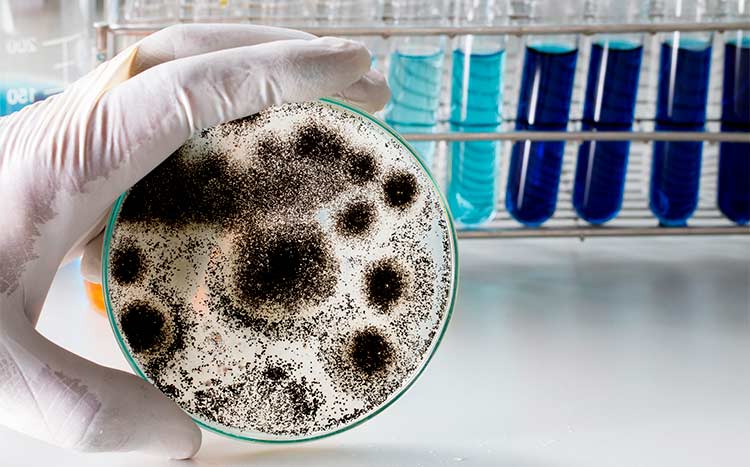Mold spores can adhere to or proliferate on various surfaces, depending on the surrounding conditions. As they enter their reproductive phase, these spores are dispersed into the atmosphere, where their inhalation can pose potential health risks.
Mold spores can live for an unlimited period on wet or damp surfaces and can survive airborne indefinitely. Mold spores need moisture to grow. When water is absent, mold spores go inactive but stay alive to restart their growth cycle once moisture is reintroduced.
Below we look at how long mold spores live on different surfaces and conditions.
Clothes
Mold spores can live on clothes for an indefinite period, depending on the conditions in which you store your clothes. Mold spores will cluster, feed, and start reproducing on clothes within 24-48 hours under the following conditions:
- When wet or moist, clothes are packed together.
- When clothes are stored in damp or poorly ventilated spaces.
- When dirty clothes are packed together and left unwashed.
These conditions provide a conducive environment for mold spores to remain active unless they are eliminated. To remove mold spores from clothes, wash or scrub mold stains from your clothes with commercial cleaning agents and household stain removers. Bleach, borax, or baking soda can get rid of mold spores living on your clothes. Washing moldy clothes in hot water and vinegar solution can kill more than 80% of mold spores.
In the air
Mold spores can remain airborne for an unspecified time until it settles on a damp surface. Contrary to popular opinion, mold spores don’t die from lack of moisture. But, they can stay dormant but alive in dry environments. Dormant or dry mold spores can travel vast distances by air and survive airborne in dry or wet conditions.
Mold spores cannot be eliminated from the air, but you can reduce their presence in your home by doing the following:
- You can decrease the amount of moisture in your home interior by using dehumidifiers and air conditioners.
- You can extract mold spores from the atmosphere with an air purifier. Air purifying devices equipped with a High-Efficiency Particulate Air (HEPA) filter can remove almost 100% of mold spores present in the air.
- You can heat the room for short periods with a continuously lit light bulb (60-100 watts) to remove moisture.
- You can place moisture-absorbing chemicals in strategic areas around your home. Small bags and sieves containing silica gel, activated alumina, anhydrous calcium sulfate, and calcium chloride can extract moisture from the air to prevent the growth and formation of mold spores.

On surfaces
Mold spores can survive indefinitely on damp surfaces that contain cellulose which mold feeds on. These include:
- Wood.
- Insulation.
- Carpet.
- Leather.
- Paper.
Wood is especially susceptible to mold spores because it is a porous surface. This means that mold spores can penetrate deep into the wood surface and live inside. Removing mold spores from wood can be difficult, and you might need to hire a mold remediation professional. However, mold spores can not grow on synthetic surfaces unless soil or dust that provides a food source is present.
- You can do the following to remove mold spores from surfaces:
You perform regular cleaning of all interior surfaces with organic mold killers such as vinegar.
- You can keep your rooms well-ventilated to reduce moisture buildup, which prevents mold growth.
- You can paint the wooden surfaces of your home interior with mold-resistant paint.
- You can dust your books and papers and keep them dry.
Without Moisture/ water
Mold spores go dormant without moisture/water. Although the lack of moisture will dry mold spores, they remain alive albeit inactive and ‘harmless’ until moist conditions return. However, dried moisture can get airborne and is dangerous to humans when inhaled.
Drying and cleaning up damp or wet spots and items in your home within
24-48 hours can completely deter mold growth.
In Your body
Ingested mold spores can remain and continue growing in your body for a few days to several weeks, depending on your health condition, how quickly you receive treatment, and the type of treatment you receive.
Toxins released by the mold spores in your system can make you sick, and the only way to remove them is for your body to produce antibodies that will destroy the mold spores or take drugs that will flush the mold spores from your system.
Use this FREE service
HomeGardenGuides.com is a free service that quickly matches you with top-voted local Mold Inspection Specialists.
You can get three estimates fast by real certified experts in your area in just 2 minutes.
- Scroll to the top of the page and enter your Zip code.
- Answer questions about your mold job
- Your roof painting details are forwarded to three local experts. They will send you a price estimate for the job and some friendly advice.
IMPORTANT: There is no obligation to hire. This is a free tool and service to be used at your pleasure.

What kills mold spores?
You can kill mold spores with chemicals or natural cleansers. These cleansers are industrial-grade chemicals and household organic cleaning agents available as ready-for-use products at supermarkets or can be diluted to rid your home interior surfaces of mold spores effectively.
They include:
Bleach
Bleach kills mold spores while simultaneously sterilizing the surface, preventing any recurring mold growth. For best results, use bleach to kill mold growing on non-porous surfaces like glass, tiles, ceramics, and metal. Bleach is not recommended for use on porous surfaces such as wood because of its inability to penetrate and kill mold spores living inside wooden surfaces.
Ammonia
A toxic chemical compound, ammonia, will kill mold spores on solid non-porous surfaces. A 50% ammonia and 50% water solution can neutralize mold growing on glass windows, tiles, bathtubs, and plastic surfaces. Spray ammonia over non-porous surfaces for the best results. However, avoid using ammonia over porous surfaces line wood because of its inability to penetrate the material to kill mold spores living inside.
Hydrogen peroxide
Hydrogen peroxide is an excellent chemical that you can use to kill mold indoors without releasing toxic fumes. Hydrogen peroxide kills mold spores on every kind of surface, including clothes, and it is safe to use around children and pets.
Vinegar
Vinegar is a safe organic mold killer with 5% to 30% acetic acid capable of killing more than 80% of mold spores. Apart from killing mold spores, you can use vinegar to deter mold growth’s recurrence on previously cleaned surfaces.
Borax
Borax is a natural and effective mold killer and inhibitor. It is safe to use indoors and does not produce dangerous toxic fumes. However, borax can have serious side effects when swallowed.
Baking soda
This everyday household cleanser is a natural mold killer that is typically used with vinegar for more potency. Baking soda is child and pet-friendly, and you can use it to kill mold growing on any surface.
Tea tree oil
It is costly, but it is one of the most effective natural mold killers. Tea tree oil is an antifungal product capable of destroying all mold variants.

What happens when you breathe in mold spores?
Breathing mold spores can cause mild to severe health problems in individuals. The typical effects of mold inhalation in healthy people include:
- Sneezing.
- Runny nose.
- Itchy and watery eyes.
- Upper respiratory tract symptoms.
However, breathing mold spores can result in severe health issues in people with serious mold allergies, pre-existing respiratory diseases, and immune suppression.
Ingesting mold spores triggers powerful reactions in people with mold allergies. Allergic fungal sinusitis is an inflammatory reaction caused by the presence of fungus particles in the sinuses. Individuals who have asthma may experience a severe asthma attack after breathing in mold spores. Symptoms include:
- Coughing.
- Wheezing.
- Shortness of breath.
- Tightening chest.
Individuals with weakened immune systems or taking immunosuppressant medication are prone to develop systemic infections after breathing in mold spores.
At what temperature do mold spores die?
You can destroy mold spores at temperatures between 140-160°F (60-71°C). However, certain molds produce heat-resistant spores that can survive extreme temperatures under certain conditions.
Will a dehumidifier kill mold?
A dehumidifier will not kill mold growing in a room, but it prevents mold by reducing the moisture that makes mold growth possible. A dehumidifier reduces moisture in the interior room atmosphere by cooling the warm air drawn in and fed over refrigerated coils, releasing cooler and dry air into the room. This process is not designed to kill mold spores, but dehumidifiers can remove mold spores present in the air.
A dehumidifier is needed in the following conditions:
- Where you can visibly see condensation on windows.
- Rooms where excess moisture results in wet stains forming on walls and ceilings.
- Rooms with overwhelming musty odors.
- Exceedingly stuffy rooms.
Apart from reducing moisture, the benefits of using a dehumidifier include:
- Reduction in the number of allergy-causing pollen and dust mites.
- Improved air quality and circulation within the home.
- Prevention of specific disease-causing bacteria and viruses.
- Prevents wooden items and furniture from moisture damage.
Do most homes have mold?
Yes, you can find mold in almost every home. A bit of moisture from humidity or condensation is all it takes for mold to form a colony and start reproducing. The common causes of mold growth in homes are moisture generated from leaks around windows, broken water pipes, leaking roofs, damp bathrooms, poorly ventilated garages, and basements, and recently flooded areas in the home.
Common indoor molds include:
Cladosporium.
- Aspergillus.
- Penicillium.
- Stachybotrys Atra (black mold).
- Fusarium.
- Chaetomium.
- Alternaria.
- Aureobasidium.
Mold can be found on almost every surface within the house, as long as there is moisture to encourage growth and cellulose that provides food is present. These include:
- Wood.
- Fabric.
- Leather.
- Paper.
- Paints.
- Insulation.
- Drywall.
- Greasy kitchen walls.
- Dust.
Although synthetic materials like nylon and acrylic are mold-resistant, they have to be cleaned regularly to remove dirt or dust, supporting mold growth.
Mold growth causes billions of dollars of damage to homes and furnishings, resulting in lost income and person-hours spent on repairs and mold remediation projects.







